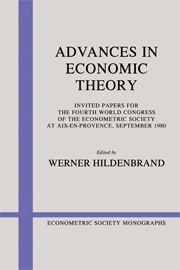Book contents
- Frontmatter
- Part I Economics of incentives
- Part II Information and the market mechanism
- Part III Non-Walrasian economics
- Part IV Repeated games
- Part V Topics in competitive analysis
- Chapter 7 The Cournotian foundations of Walrasian equilibrium theory: an exposition of recent theory
- Chapter 8 Recent results on the existence of Cournot equilibrium when efficient scale is small relative to demand
- Part VI Applied macroeconomics
- Part VI Industrial organization
Chapter 8 - Recent results on the existence of Cournot equilibrium when efficient scale is small relative to demand
from Part V - Topics in competitive analysis
Published online by Cambridge University Press: 05 January 2013
- Frontmatter
- Part I Economics of incentives
- Part II Information and the market mechanism
- Part III Non-Walrasian economics
- Part IV Repeated games
- Part V Topics in competitive analysis
- Chapter 7 The Cournotian foundations of Walrasian equilibrium theory: an exposition of recent theory
- Chapter 8 Recent results on the existence of Cournot equilibrium when efficient scale is small relative to demand
- Part VI Applied macroeconomics
- Part VI Industrial organization
Summary
Introduction
This chapter concerns a line of research that begins with William Novshek's remarkable Ph.D. dissertation, and then extends his result on the existence of Cournot partial equilibrium with entry to the case of general economic equilibrium. I plan to write about the purpose of this research and the recent discoveries that have been made. In addition, I will remark upon the important work that lies ahead. I will give only a broad outline, leaving out either proofs or details. I will try to provide some historical perspective, but will make no attempt to touch as many bases as might be expected in a survey.
First, let me explain why I feel that the problems under consideration are central to the theory of value. Put briefly, the lesson of the analysis of perfect competition that has been carried out over the past 25 to 30 years is this: It is possible to formulate a rigorous model of economic equilibrium for economies in which: (a) markets exist for all commodities, and (b) every agent in sight takes prices as given. Furthermore, under some rather general conditions, each economy has at least one equilibrium state, and there is a close relationship between the set of Pareto optima for economies and the set of equilibria. To me, this means that a logical next step to take in order to deepen our understanding of the workings of perfect competition is to address the following two questions. Under conditions of laissez faire, and assuming that agents are intelligent strategists: (a) What markets will exist, and (b) When will agents behave as if prices are beyond their control? The research on which I will report represents an attempt to shed light on the second question.
- Type
- Chapter
- Information
- Advances in Economic Theory , pp. 225 - 234Publisher: Cambridge University PressPrint publication year: 1983



